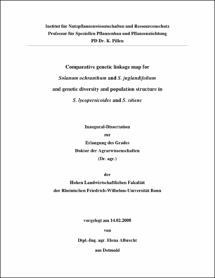Albrecht, Elena: Comparative genetic linkage map for Solanum ochranthum and S. juglandifolium and genetic diversity and population structure in S. lycopersicoides and S. sitiens . - Bonn, 2008. - Dissertation, Rheinische Friedrich-Wilhelms-Universität Bonn.
Online-Ausgabe in bonndoc: https://nbn-resolving.org/urn:nbn:de:hbz:5N-14382
Online-Ausgabe in bonndoc: https://nbn-resolving.org/urn:nbn:de:hbz:5N-14382
@phdthesis{handle:20.500.11811/3257,
urn: https://nbn-resolving.org/urn:nbn:de:hbz:5N-14382,
author = {{Elena Albrecht}},
title = {Comparative genetic linkage map for Solanum ochranthum and S. juglandifolium and genetic diversity and population structure in S. lycopersicoides and S. sitiens },
school = {Rheinische Friedrich-Wilhelms-Universität Bonn},
year = 2008,
note = {The four nightshades Solanum ochranthum, S. juglandifolium, S. lycopersicoides and S. sitiens compose the basal ranks of the tomato clade (S. sect. lycopersicum and S. sect. juglandifolium), representing a link between cultivated potato (S. tuberosum) and cultivated tomato (S. lycopersicum). All four exhibit potato-like morphological features and are isolated by strong reproductive barriers from tomato. S. ochranthum and S. juglandifolium occupy wet, tropical regions in Colombia, Ecuador and Peru while S. lycopersicoides and S. sitiens are narrowly endemic in the arid south of Peru and Northern Chile.
The S. lycopersicoides and S. sitiens genome lacks one of the major whole-arm paracentric inversions that differentiate tomato from potato. To investigate the genomic structure in S. ochranthum and S. juglandifolium, a genetic linkage map was constructed from 66 F2 plants of an interspecific mapping population using 96 CAPS, 19 RFLPs and 17 microsatellites. Segregation distortion affected one third of the markers, and 13 putative segregation distorter loci were identified on nine out of twelve chromosomes. Total map length spanned 790 cM, representing 42 % length reduction relative to the tomato reference map. As expected, the degree of collinearity with the tomato genome was high. Evidence was found for a reciprocal whole-arm translocation among the parental species involving chromosome 8 and 12.
Levels of genetic diversity and genetic structure were investigated for the two narrowly endemic tomatoes S. lycopersicoides and S. sitiens. Fourteen and seven populations, respectively, were analyzed with a total of 11 allozyme and 15 microsatellite markers. Less variability was detected at the protein compared to the DNA level. S. lycopersicoides appeared more diverse than S. sitiens from the microsatellite analysis, whereas the opposite picture was presented by the allozyme analysis. Congruence between the two marker systems was low in the former species. Populations of S. sitiens were characterized by severe population fragmentation and exhibited signs of recent bottleneck events. A pattern of isolation by distance was evident in both species, and several alleles and diversity estimates exhibited geographic clines, primarily across the latitudinal range. Phylogenetic analyses revealed three major population clusters for each species; a northern, a central and a southern.},
url = {https://hdl.handle.net/20.500.11811/3257}
}
urn: https://nbn-resolving.org/urn:nbn:de:hbz:5N-14382,
author = {{Elena Albrecht}},
title = {Comparative genetic linkage map for Solanum ochranthum and S. juglandifolium and genetic diversity and population structure in S. lycopersicoides and S. sitiens },
school = {Rheinische Friedrich-Wilhelms-Universität Bonn},
year = 2008,
note = {The four nightshades Solanum ochranthum, S. juglandifolium, S. lycopersicoides and S. sitiens compose the basal ranks of the tomato clade (S. sect. lycopersicum and S. sect. juglandifolium), representing a link between cultivated potato (S. tuberosum) and cultivated tomato (S. lycopersicum). All four exhibit potato-like morphological features and are isolated by strong reproductive barriers from tomato. S. ochranthum and S. juglandifolium occupy wet, tropical regions in Colombia, Ecuador and Peru while S. lycopersicoides and S. sitiens are narrowly endemic in the arid south of Peru and Northern Chile.
The S. lycopersicoides and S. sitiens genome lacks one of the major whole-arm paracentric inversions that differentiate tomato from potato. To investigate the genomic structure in S. ochranthum and S. juglandifolium, a genetic linkage map was constructed from 66 F2 plants of an interspecific mapping population using 96 CAPS, 19 RFLPs and 17 microsatellites. Segregation distortion affected one third of the markers, and 13 putative segregation distorter loci were identified on nine out of twelve chromosomes. Total map length spanned 790 cM, representing 42 % length reduction relative to the tomato reference map. As expected, the degree of collinearity with the tomato genome was high. Evidence was found for a reciprocal whole-arm translocation among the parental species involving chromosome 8 and 12.
Levels of genetic diversity and genetic structure were investigated for the two narrowly endemic tomatoes S. lycopersicoides and S. sitiens. Fourteen and seven populations, respectively, were analyzed with a total of 11 allozyme and 15 microsatellite markers. Less variability was detected at the protein compared to the DNA level. S. lycopersicoides appeared more diverse than S. sitiens from the microsatellite analysis, whereas the opposite picture was presented by the allozyme analysis. Congruence between the two marker systems was low in the former species. Populations of S. sitiens were characterized by severe population fragmentation and exhibited signs of recent bottleneck events. A pattern of isolation by distance was evident in both species, and several alleles and diversity estimates exhibited geographic clines, primarily across the latitudinal range. Phylogenetic analyses revealed three major population clusters for each species; a northern, a central and a southern.},
url = {https://hdl.handle.net/20.500.11811/3257}
}






